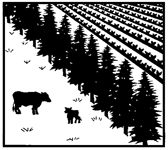U.S. Department of Agriculture: Forest Service -- National Agroforestry Center
Date of this Version
11-1-1997
Abstract
Although some form of silvopasture management has been practiced for centuries, silvopasture as an agroforestry practice is specifically designed and managed for the production of trees, tree products, forage, and livestock. Silvopasture results when forage crops are deliberately introduced or enhanced in a timber production system, or timber crops are deliberately introduced or enhanced in a forage production system. As a silvopasture, timber and pasture are managed as a single integrated system.
Silvopastoral systems are designed to produce a high-value timber component, while providing short-term cash flow from the livestock component. The interactions among timber, forage, and livestock are managed intensively to simultaneously produce timber commodities, a high quality forage resource, and efficient livestock production. Overall, silvopastures can provide economic returns while creating a sustainable system with many environmental benefits. Well-managed silvopastures offer a diversified marketing opportunity that can stimulate rural economic development.


Comments
Published by National Agroforestry Center, USDA Forest Service, Rocky Mountain Station, USDA Natural Resources Conservation Service, East Campus – UNL, Lincoln, Nebraska 68583-0822.